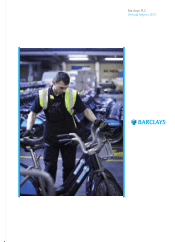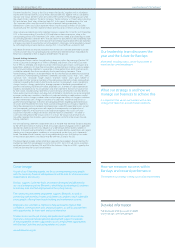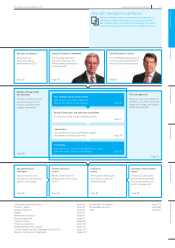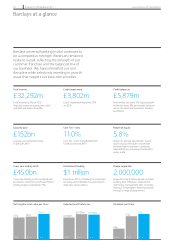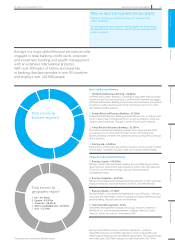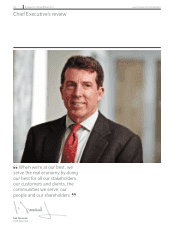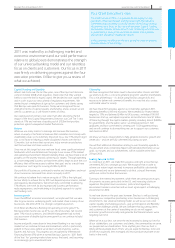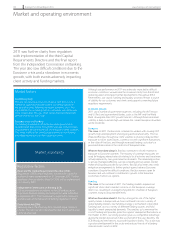Barclays 2011 Annual Report Download - page 10
Download and view the complete annual report
Please find page 10 of the 2011 Barclays annual report below. You can navigate through the pages in the report by either clicking on the pages listed below, or by using the keyword search tool below to find specific information within the annual report.
Market and operating environment
Although our performance in 2011 was adversely impacted by difficult
economic conditions, we welcome the increased clarity from the UK and
global regulators and expect further developments throughout 2012.
Nevertheless, our capital, funding and liquidity positions remain a source
of stability for our customers and clients and support us meeting future
regulatory requirements.
Economic growth
2011 saw a number of government agencies, including the UK Treasury
and US Fed, and supranational bodies, such as the IMF and the World
Bank, downgrade their GDP growth forecasts. Although financial market
volatility is likely to remain high, we believe the current European downturn
will be moderate.
Eurozone
The issue. In 2011, the Eurozone continued to weaken with slowing GDP
growth, high unemployment and ongoing political uncertainty. This has
impacted Barclays through low client volumes as investors reduced their
exposure to riskier asset classes, currency risk with significant fluctuations
in the value of the Euro, and through increased funding costs due to a
perceived deterioration in the credit risk of European banks.
What we have done about it. Barclays continues to closely monitor its
exposure to Eurozone countries. The majority of sovereign exposures are
used for hedging interest rate risk relating to local activities and have been
actively replaced by non-government instruments. The remaining portion
is actively managed reflecting our role as leading primary dealer, market
maker and liquidity provider to our clients. Barclays also enters into credit
mitigation arrangements to further protect against adverse Eurozone
conditions. Despite the difficult conditions, Barclays remains open for
business and will continue to contribute to growth in the Eurozone
economies in which we operate.
Funding
The issue. In the summer of 2011, the funding markets experienced
significant stress due to market concerns on the European sovereign
debt crisis, resulting in sovereign bond yields for a number of European
countries rising to unsustainable levels.
What we have done about it. Barclays emerged as one of the higher
quality names in Europe and we have continued to access a variety of
global funding markets. Our funding strategy is to maintain a diversified
funding base, access a variety of alternate funding sources and hold
liquidity to meet unexpected demands. This enables us to minimise the
cost of funding and provides protection against unexpected fluctuations in
the market. In 2011, our strong position gave us a competitive advantage
during the market dislocation in the second half of the year. Recently, the
ECB introduced mechanisms to provide liquidity to banks. This action was
a positive development for the sector and reduces the risk of a funding-
induced credit crunch in 2012.
2011 saw further clarity from regulators
with implementation of the third Capital
Requirements Directive and the final report
from the Independent Commission on Banking.
The year also saw difficult conditions due to the
Eurozone crisis and a slowdown in economic
growth, with both events adversely impacting
client activity and funding markets.
Market factors
Economic growth
The year saw downward revisions of global GDP forecasts by a
number of supranational bodies with a worsening outlook on
the pace of recovery following the recent economic crisis. This
impacted Barclays income growth as customers and clients were
more conservative. This was offset by the improved impairment
performance across the Group.
Eurozone crisis and funding
The funding requirements of certain Eurozone governments
caused market dislocations through the year due to investor fears
of government default and the risk of contagion to other countries.
This made it difficult for some European banks to raise funding
and added to pressures on their liquidity positions.
Regulatory factors
Basel and the Capital Requirements Directive (CRD)
Regulations (CRD3) requiring banks to hold more capital for
market risk were implemented on 31 December 2011. Further
regulatory change linked to Basel 3/CRD4 will be implemented
on 1 January 2013.
Independent Commission on Banking (ICB)
ICB recommendations on reforms to the UK banking sector
to promote financial stability and competition were submitted
in September 2011. The Government is expected to announce
a white paper on the future of UK banking regulation in 2012.
Dodd-Frank Act (DFA)
Becoming law in the US in July 2010, the DFA impact remains
unclear. The rules are yet to be implemented and, in some areas,
yet to be proposed.
Market uncertainty
08 Barclays PLC Annual Report 2011 www.barclays.com/annualreport

